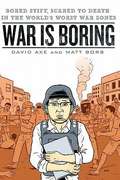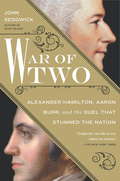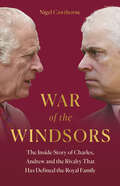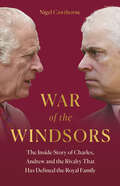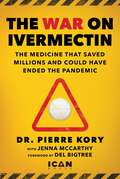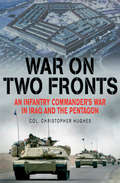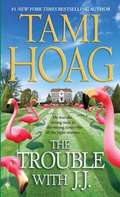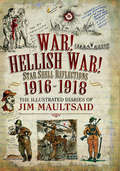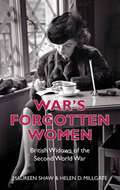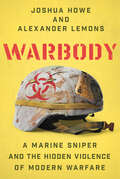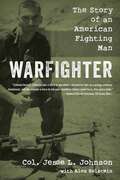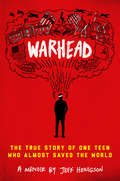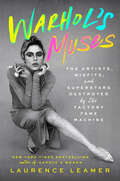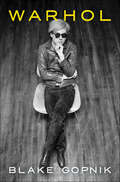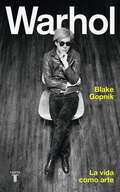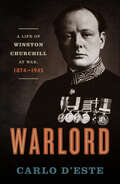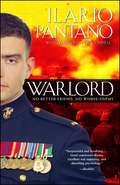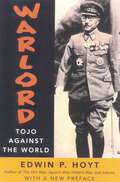- Table View
- List View
War is Boring
by David AxeThe war memoir as graphic novel-an utterly unforgettable and highly original look at war in the 21st century. Street battles with spears and arrows in sweltering East Timor. Bone- jarring artillery duels in Afghanistan's mountains. Long patrols on the sandy wastes of southern Iraq. For four years, war was life for David Axe. He was alternately bored out of his mind and completely terrified. It was strangely addictive. As a correspondent for The Washington Times, C-SPAN and BBC Radio, Axe flew from conflict to conflict, reveling in death, danger, and destruction abroad while, back in D. C. , his apartment gathered dust, his plants died, and his relationships withered. War reporting was physically, emotionally, and financially draining-and disillusioning. Loosely based on the web comic of the same name, with extensive new material, War Is Boring takes us to Lebanon and Somalia; to arms bazaars across the United States; to Detroit, as David tries to reconnect with his family-and to Chad, as David attempts to bring attention to the Darfur genocide. <P><P> <i>Advisory: Bookshare has learned that this book offers only partial accessibility. We have kept it in the collection because it is useful for some of our members. Benetech is actively working on projects to improve accessibility issues such as these.</i>
War of Numbers: An Intelligence Memoir of the Vietnam War's Uncounted Enemy (Eyewitness Memoirs Ser.)
by Sam AdamsIn vibrant, engaging prose, this memoir from inside the belly of US intelligence operations reveals what fundamentally went wrong for the US and its allies, and why the Vietnam War was never "winnable." A cautionary tale about the perils of politicizing and manipulating honest intelligence.For political reasons, the Johnson and Nixon administrations wanted to control the narrative about US prospects in Vietnam. In 1965, low level CIA analyst Sam Adams was transferred from the Congo desk to Southeast Asia, where he was charged with assessing enemy morale and counting their ranks. Only the enemy strength estimate he came up with as the CIA's official head counter varied wildly from the official estimates being produced by military intelligence and released by the White House for consumption by Congress, the media, troops in the field and the American electorate. Adams' findings pointed to the conclusion that the war was unwinnable, but when politicians and military leaders failed to release let alone acknowledge his findings, he knew the intelligence was being politicized and embarked on a one man crusade to hold those in power accountable and expose the truth.
War of Two
by John SedgwickA provocative and penetrating investigation into the rivalry between Alexander Hamilton and Aaron Burr, whose infamous duel left the Founding Father dead and turned a sitting Vice President into a fugitive. In the summer of 1804, two of America's most eminent statesmen squared off, pistols raised, on a bluff along the Hudson River. That two such men would risk not only their lives but the stability of the young country they helped forge is almost beyond comprehension. Yet we know that it happened. The question is why. In War of Two, John Sedgwick explores the long-standing conflict between Founding Father Alexander Hamilton and Vice President Aaron Burr. A study in contrasts from birth, they had been compatriots, colleagues, and even friends. But above all they were rivals. Matching each other's ambition and skill as lawyers in New York, they later battled for power along political fault lines that would not only decide the future of the United States, but define it. A series of letters between Burr and Hamilton suggest the duel was fought over an unflattering comment made at a dinner party. But another letter, written by Hamilton the night before the event, provides critical insight into his true motivation. It was addressed to former Speaker of the House Theodore Sedgwick, a trusted friend of both men, and the author's own ancestor. John Sedgwick suggests that Hamilton saw Burr not merely as a personal rival but as a threat to the nation. Burr would prove that fear justified after Hamilton's death when, haunted by the legacy of his longtime adversary, he embarked on an imperial scheme to break the Union apart.From the Hardcover edition.
War of Two: Alexander Hamilton, Aaron Burr, and the Duel that Stunned the Nation
by John SedgwickA provocative and penetrating investigation into the rivalry between Alexander Hamilton and Aaron Burr, whose infamous duel left the Founding Father dead and turned a sitting Vice President into a fugitive. In the summer of 1804, two of America's most eminent statesmen squared off, pistols raised, on a bluff along the Hudson River. That two such men would risk not only their lives but the stability of the young country they helped forge is almost beyond comprehension. Yet we know that it happened. The question is why. In War of Two, John Sedgwick explores the long-standing conflict between Founding Father Alexander Hamilton and Vice President Aaron Burr. A study in contrasts from birth, they had been compatriots, colleagues, and even friends. But above all they were rivals. Matching each other's ambition and skill as lawyers in New York, they later battled for power along political fault lines that would not only decide the future of the United States, but define it. A series of letters between Burr and Hamilton suggest the duel was fought over an unflattering comment made at a dinner party. But another letter, written by Hamilton the night before the event, provides critical insight into his true motivation. It was addressed to former Speaker of the House Theodore Sedgwick, a trusted friend of both men, and the author's own ancestor. John Sedgwick suggests that Hamilton saw Burr not merely as a personal rival but as a threat to the nation. Burr would prove that fear justified after Hamilton's death when, haunted by the legacy of his longtime adversary, he embarked on an imperial scheme to break the Union apart.From the Hardcover edition.
War of the Bloods in My Veins
by Terrie Williams Dashaun Jiwe" Morris T. RodgersBy turns harrowing, moving, and ultimately redemptive, this is a war story -- a war that rages out of control on the streets of the United States, claiming the lives of our loved ones and neighbors. In this memoir, complete with child soldiers, unspeakable violence, and eventual salvation, we witness the journey of an East Coast member of the notorious Bloods gang coming to terms with the lost boy he was and the transformation into the man he wants to become. Unlike the child warriors of Mozambique and Sierra Leone, gang members and the wars they wage are the United States' homegrown nightmare. Lacking protection, support, or any alternatives, Dashaun Morris is forced into battle for the first time at age eleven, in the streets of Phoenix, when a friend's older brothers put him in a car filled with 40s and weed smoke, put a gun in his hands, then make him point it at the men on the corner and squeeze the trigger. The targets are Crips, of course, and, as Morris writes, "In the darkness of the streets, my childhood is murdered.... I am reborn -- a gangster." In this haunting, violent memoir, Morris takes us through an American childhood turned grotesquely inside out. In the fourth grade, he loses his first friend in a drive-by shooting. By high school he is the man, a champion on the football field by day and a reputable banger on his 'hood turf by night. Living the life of a gang banger, Morris does it all -- drug dealing, jacking, and continuing the aimless war with rival gang members -- almost opening fire one night on a close friend, a cheerleader, as she hangs out with young men he mistakes for Crips. He eventually makes it to college on a football scholarship, but on the verge of being drafted by the NFL, Morris can't escape his gang-banging mentality and gets caught up in crimes that snatch away all future hopes. Sitting in a prison cell, he anticipates the birth of his first child while counting the friends he's buried. War of the Bloods in My Veins is part of Morris's redemption, a cry to his brothers that gang life is mental illness. It is a rare and brutally honest look into the relentless storm of abandonment, violence, crime, death, and the endless rush toward the complete and utter self-annihilation that plagues the lives of the young "soldiers" who die every day in our streets.
War of the Windsors: The Inside Story of Charles, Andrew and the Rivalry That Has Defined the Royal Family
by Nigel CawthorneTelling the story of their lives from children to modern day, this fascinating and revelatory new book will look at the fraught relationship (and fiery rivalry) between King Charles and Prince Andrew.Raised for vastly different futures, one burdened with the responsibility of becoming the future king and the other destined to live in his shadow, Charles and Andrew have spent their lives on different sides of the same coin.War of the Windsors tells, for the first time, the complete story of Charles and Andrew from their diverging childhoods to their current struggles. It looks at the distinct but overlapping stories of the two heirs, from being separated in their early years and the Queen's supposed overindulgence of Andrew to the competition for Lady Diana and finally, Charles' ascension to throne while his brother is stripped of Royal duties. And it explores whether, with the scandals around Andrew still fresh in public memory, Charles will ever let his brother back into the family.With extensive research and expert sourcing, War of the Windsors is the incredible inside story of a family in turmoil. Recounting the highs and lows of a brotherhood then turned into a rivalry, royal author and journalist Nigel Cawthorne looks at the makings of a decades long feud and questions whether, ultimately, the brothers will one day band together again.
War of the Windsors: The Inside Story of Charles, Andrew and the Rivalry That Has Defined the Royal Family
by Nigel CawthorneTelling the story of their lives from children to modern day, this fascinating and revelatory new book will look at the fraught relationship (and fiery rivalry) between King Charles and Prince Andrew.Raised for vastly different futures, one burdened with the responsibility of becoming the future king and the other destined to live in his shadow, Charles and Andrew have spent their lives on different sides of the same coin.War of the Windsors tells, for the first time, the complete story of Charles and Andrew from their diverging childhoods to their current struggles. It looks at the distinct but overlapping stories of the two heirs, from being separated in their early years and the Queen's supposed overindulgence of Andrew to the competition for Lady Diana and finally, Charles' ascension to throne while his brother is stripped of Royal duties. And it explores whether, with the scandals around Andrew still fresh in public memory, Charles will ever let his brother back into the family.With extensive research and expert sourcing, War of the Windsors is the incredible inside story of a family in turmoil. Recounting the highs and lows of a brotherhood then turned into a rivalry, royal author and journalist Nigel Cawthorne looks at the makings of a decades long feud and questions whether, ultimately, the brothers will one day band together again.
War of the Windsors: The Inside Story of Charles, Andrew and the Rivalry That Has Defined the Royal Family
by Nigel CawthorneTelling the story of their lives from children to modern day, this fascinating and revelatory new book will look at the fraught relationship (and fiery rivalry) between King Charles and Prince Andrew.Raised for vastly different futures, one burdened with the responsibility of becoming the future king and the other destined to live in his shadow, Charles and Andrew have spent their lives on different sides of the same coin.War of the Windsors tells, for the first time, the complete story of Charles and Andrew from their diverging childhoods to their current struggles. It looks at the distinct but overlapping stories of the two heirs, from being separated in their early years and the Queen's supposed overindulgence of Andrew to the competition for Lady Diana and finally, Charles' ascension to throne while his brother is stripped of Royal duties. And it explores whether, with the scandals around Andrew still fresh in public memory, Charles will ever let his brother back into the family.With extensive research and expert sourcing, War of the Windsors is the incredible inside story of a family in turmoil. Recounting the highs and lows of a brotherhood then turned into a rivalry, royal author and journalist Nigel Cawthorne looks at the makings of a decades long feud and questions whether, ultimately, the brothers will one day band together again.
War on Ivermectin: The Medicine that Saved Millions and Could Have Ended the Pandemic
by Pierre Kory Jenna McCarthyBig Pharma and health agencies cry, &“Don&’t take ivermectin!&” A media storm follows. Why then, does the science say the opposite?&” Ivermectin is a dirty word in the media. It doesn&’t work. It&’s a deadly horse dewormer. Prescribe or promote it and you&’ll be called a right-wing quack, be banned from social media, or lose your license to practice medicine. And yet, entire countries wiped out the virus with it, and more than ninety-five studies now show it to be unequivocally effective in preventing and treating Covid-19. If it didn&’t work, why was there a coordinated global campaign to cancel it? What&’s the truth about this decades-old, Nobel Prize-winning medication? The War on Ivermectin is the personal and professional narrative of Dr. Pierre Kory and his crusade to recommend a safe, inexpensive, generic medicine as the key to ending the pandemic. Written with Jenna McCarthy, Dr. Kory&’s story chronicles the personal attacks, professional setbacks, and nefarious efforts of the world&’s major health agencies and medical journals to dismiss and deny ivermectin&’s efficacy. Part personal narrative, part scathing expose, The War on Ivermectin highlights the catastrophic impacts of the mass media censorship and relentless propaganda that led to the greatest humanitarian crisis in history. Although numerous studies and epidemiologic data have shown that millions of lives were saved globally with the systematic use of ivermectin, many more millions perished. This carnage was the direct result of what Dr. Kory eventually discovered to be the pharmaceutical industry&’s silent but deadly war on generic medicines and the corrupt, captured medical and media systems that allow it to continue. For anyone who thought Covid-19 was the enemy, Dr. Kory&’s book will leave no doubt that the true adversary in this war is a collective cabal of power-hungry elites who put profits over people and will stop at nothing in their quest for control.The War on Ivermectin is published through ICAN PRESS, an imprint of Skyhorse Publishing. ICAN (Informed Consent Action Network) is a nonprofit organization investigating the safety of medical procedures, pharmaceutical drugs, and vaccines while advocating for people&’s right to informed consent.
War on Two Fronts: An Infantry Commander's War in Iraq and the Pentagon
by Col. Christopher HughesA vivid memoir of the conflict&’s early years combined with &“an insightful review of our problems in Iraq&” (Publishers Weekly). Winner of The Army Historical Foundation&’s Distinguished Writing Award. Shortly after the launch of Operation Iraqi Freedom, the war in Iraq became the most confusing in US history, the high command not knowing who to fight, who was attacking coalition troops, and who among the different Iraqi groups were fighting each other. Yet there were a few astute officers like Lt. Col. Christopher Hughes, commanding the 2nd Battalion of the 327th Infantry Regiment, 101st Airborne, who sensed the complexity of the task from the beginning. In War on Two Fronts, Lt. Col. Hughes writes movingly of his &“no-slack&” battalion at war in Iraq. The war got off to a bang for Hughes when his brigade command tent was fragged, leaving him briefly in charge of the brigade. Amid the nighttime confusion of fourteen casualties, a nearby Patriot missile blasted off, panicking nearly everyone while mistakenly bringing down a British Tornado fighter-bomber. As Hughes&’ battalion forged into Iraq, they successfully liberated the city of Najaf, securing the safety of Grand Ayatollah Sistani and the Mosque of Ali while showing an acute cultural awareness that caught the world&’s attention. It was a feat that landed Hughes within the pages of Time, Newsweek, and other publications. The Screaming Eagles of the 101st Airborne then implemented creative programs in the initial postwar occupation, including harvesting the national wheat and barley crops while combating nearly invisible insurgents. Conscious that an army battalion is a community of some seven-hundred-plus households, and that when a unit goes off to war, the families are intimately connected in our internet age, Hughes makes clear the strength of those connections and how morale is best supported at both ends. Transferred to Washington after his tour, Hughes also writes an illuminating account of the herculean efforts of many in the Pentagon to work around the corporatist elements of its bureaucracy in order to better understand counterinsurgency and national reconstruction, which Lawrence of Arabia described as &“like learning to eat soup with a knife.&” This book helps explain the sources of mistakes made—and the process needed to chart a successful strategy. Written with candor and no shortage of humor, mixed with brutal scenes of combat and frank analysis, it is a must-read for all who seek insight into our current situation in the Mideast.
War on the Run: The Epic Story of Robert Rogers and the Conquest of America’a First Frontier
by John F. RossRoss, executive editor of American Heritage magazine, has written this biography of American colonial frontiersman Robert Rogers to reveal how his observations of Native American warriors led to combat strategies that are still effective today. Written for general audiences, this book explains how Rogers trained and led an army of farmers, scouts and woodsmen on a series of military missions that are still considered impossible today. The author also explains how Rogers' 28 Rules of Engagement laid the groundwork for the Revolutionary War, and how his explorations of the frontier inspired the Lewis and Clark expedition. Annotation ©2009 Book News, Inc., Portland, OR (booknews.com)
War! Hellish War! Star Shell Reflections, 1916–1918: The Illustrated Diaries of Jim Maultsaid
by Barbara McCluneJim Maultsaid's illustrated diaries of his Great War service offer a unique and completely original perspective of a fighting mans experiences.Although an American citizen Jim was living in Donegal in 1914 and first joined the Young Citizens Volunteers and then the British Army. On 1 July 1916 the first day of the Somme, Sergeant Maultsaid was seriously wounded. To quote from his diary as he lay in no-mans-land The most awful cries rent the night air it was a shambles it was Hell with the lid off it was. Unlike so many, Jim survived and was hospitalised in Blighty. After a spell in Northern Ireland, he was selected for officer training at Cambridge. He was commissioned into The Chinese Labour Corps and his words and art work throw fascinating light on this little known but invaluable organization. Jims admiration for the CLCs contribution and culture is obvious.War! Hellish War! is more than a Great War diary it is a masterpiece and a collectors item of great historical and educational value. Despite the countless records of this conflict there is nothing to compare it with.
War's End: An Eyewitness Account of America's Last Atomic Mission
by Charles W. Sweeney James A. Antonucci Marion K. AntonucciOn August 9, 1945, on the tiny island of Tinian in the South Pacific, a twenty-five-year-old American Army Air Corps major named Charles W. Sweeney climbed aboard a B-29 Superfortress in command of his first combat mission, one devised specifically to bring a long and terrible war to a necessary conclusion. In the belly of his bomber, Bock's Car, was a newly developed, fully armed weapon that had never been tested in a combat situation. It was a weapon capable of a level of destruction never before dreamed of in the history of the human race, a bomb whose terrifying aftershock would ultimately determine the direction of the twentieth century and change the world forever. The last military officer to command an atomic mission, Major General Charles W. Sweeney has the unique distinction of having been an integral part of both the Hiroshima and the Nagasaki bombing runs. Now updated with a new epilogue from the co-author, his book is an extraordinary chronicle of the months of careful planning and training; the setbacks, secrecy, and snafus; and the nerve-shattering final seconds and the astonishing aftermath of what is arguably the most significant single event in modern history: the employment of an atomic weapon during wartime. The last military officer to command an atomic mission, Major General Charles W. Sweeney has the unique distinction of having been an integral part of both the Hiroshima and the Nagasaki bombing runs. His book is an extraordinary chronicle of the months of careful planning and training; the setbacks, secrecy, and snafus; and the nerve-shattering final seconds and the astonishing aftermath of what is arguably the most significant single event in modern history: the employment of an atomic weapon during wartime.
War's Forgotten Women: British Widows of the Second World War
by Helen D Millgate Maureen ShawThe Second World War widows were the ‘forgotten women’, largely ignored by the government and the majority of the population. The men who died in the service of their country were rightly honoured, but the widows and orphans they left behind were soon forgotten. During the war and afterwards in post-war austerity Britain their lives were particularly bleak. The meagre pensions they were given were taxed at the highest rate and gave them barely enough to keep body and soul together, let alone look after their children. Through their diaries, letters and personal interviews we are given an insight into post-war Britain that is a moving testament to the will to survive of a generation of women. The treatment of these war widows was shameful and continued right up to 1989. This is their story.
War's Nomads: A Mobile Radar Unit in Pursuit of Rommel during the Western Desert Campaign, 1942–3
by Frederick Grice&“The only known detailed account in existence of the small radar units who played a key part in the Western Desert Campaign . . . Highly recommended&” (Military Modelcraft International). War&’s Nomads is an evocative account of one man&’s experience of life in a mobile radar unit after the battle of El Alamein as Rommel&’s Afrika Korps was relentlessly pursued across the desert through Egypt, Libya, and Tunisia by the Eighth Army. After Fred Grice was called up in 1941, he kept two journals of his experiences. The first deals with waiting to embark after initial training, the journey to the battle zone, and the privations of a low-ranking AC. Daily life onboard a ship is vividly brought to life with details of routine, the cramped conditions, the banter and hobbies used to pass the time by the troops, and the luxurious-by-contrast existence of the officers. The second gives a detailed account of the activities of Unit 606, a radar crew that follows just behind the battlefront. 606 provided radio-detection for the advanced landing grounds being used by RAF fighter-bomber squadrons, because these landing strips, in turn, were the target of the German Luftwaffe and Italian Air Force attacks. It was a tiny unit, never more than ten men, frequently operating for protracted periods in complete isolation. Fred Grice&’s account lyrically evokes the landscape and the often tense and dangerous environment they operated in, pitching the reader into the experience of traveling with the unit in a three-ton truck, finding ingenious solutions to lack of rations and living space, even commandeering an abandoned boat to relax in the sea, while constantly needing to be alert to dodge air attacks. Along with these colorful first-person accounts, War&’s Nomads includes an authoritative introduction explaining the background to the military events of the Western Desert campaign, and the purpose of 606&’s mission, which Grice for security reasons could not talk about: to get to a selection of the two hundred or so landing grounds in the desert with all speed—and then defend them against air attack by using a light warning radar set developed to go operational within an hour.
Warbody: A Marine Sniper and the Hidden Violence of Modern Warfare
by Joshua Howe Alexander LemonsA friendship between an environmental historian and a chronically ill US Marine yields a powerful exploration into the toxic effects of war on the human body. Alexander Lemons is a Marine Corps scout sniper who, after serving multiple tours during the Iraq War, returned home seriously and mysteriously ill. Joshua Howe is an environmental historian who met Lemons as a student in one of his classes. Together they have crafted a vital book that challenges us to think beyond warfare’s acute violence of bullets and bombs to the “slow violence” of toxic exposure and lasting trauma. In alternating chapters, Lemons vividly describes his time in Fallujah and elsewhere during the worst of the Iraq War, his descent into a decade-long battle with mysterious and severe sickness, and his return to health; Howe explains, with clarity and scientific insight, the many toxicities to which Lemons was exposed and their potential consequences. Together they cover the whirlwind of toxic exposures military personnel face from the things they touch and breathe in all the time, including lead from bullets, jet fuel, fire retardants, pesticides, mercury, dust, and the cocktail of toxicants emitted by the open-air “burn pits” used in military settings to burn waste products like paint, human waste, metal cans, oil, and plastics. They also consider PTSD and traumatic brain injury, which are endemic among the military and cause and exacerbate all kinds of physical and mental health problems. Finally, they explore how both mainstream and alternative medicine struggle to understand, accommodate, and address the vast array of health problems among military veterans. Warbody challenges us to rethink the violence we associate with war and the way we help veterans recover. It is a powerful book with an urgent message for the nearly twenty million Americans who are active military or veterans, as well as for their families, their loved ones, and all of us who depend on their service.
Warfighter: The Story of an American Fighting Man
by Col. Jesse L. JohnsonIn Warfighter, Colonel Jesse L. Johnson, one of the most decorated living American veterans, recounts the action-packed true-life tale of a man who stood and fought at the crossroads of history. Spanning forty years of conflict, from the jungles of Vietnam to the deserts of Iran and Iraq, never has a modern military memoir covered such a vast landscape of all-out warfare. Never has one man fought on the frontlines of so many of America&’s most heroic battles. Johnson led the most elite forces on operations that defined eras past and present, mentoring young soldiers who would rise to become some of America&’s greatest generals. He held the ear of princes, kings, presidents, and even Hollywood movie stars. With an all-star cast worthy of an epic war film, this extraordinary hero&’s journey sheds new light on some of the most transformative events of our time—crises, conflicts and covert operations that have shaped the world as we know it today. More important, Warfighter offers us a deeper understanding of the personal sacrifice and human toll of a lifetime at war, and the honor-bound code of a man whose instinct in battle was to always charge ahead of those under his command—into the fight.
Warhead: The True Story of One Teen Who Almost Saved the World
by Jeff HenigsonAn often hilarious and always relevant memoir about one teen boy's battle with brain cancer and his Starlight Children's Foundation wish: to meet Mikhail Gorbachev in Russia and plead for nuclear disarmament and world peace. <P><P>It's 1986, and Jeff is an average fifteen-year-old: he thinks a lot about dating, he bounces around with his friends, and he's trying his hardest to get a car. Conversely, the world around him feels crazy: the United States and the Soviet Union are at glaring odds, with their leaders in a standoff, and that awful word, "nuclear," is on everyone's mind. Then, boom--Jeff learns that he has brain cancer and it's likely terminal. Well, that puts a damper on his summer plans and romantic prospects, doesn't it?Jeff's family rallies around him, but they are fiercely complicated--especially Jeff's father, a man who can't say "I love you" even during the worst of Jeff's treatment. So when the Starlight Children's Foundation offers to grant Jeff a wish, he makes one certain to earn his father's respect: he asks to travel to Moscow and meet with Mikhail Gorbachev to discuss nuclear disarmament and ending the Cold War. Nothing like achieving world peace to impress a distant father, right? Jeff has always been one to aim high. <P><P>Jeff's story is dark, but it's also funny, romantic, and surprising. As his life swings from incredibly ordinary to absolutely incredible, he grapples with the big questions of mortality, war, love, hope, and miracles.
Warhol's Muses: The Artists, Misfits, and Superstars Destroyed by the Factory Fame Machine
by Laurence LeamerONE OF &“12 NEW NONFICTION BOOKS YOU NEED TO READ IN 2025&”—THE OBSERVERA &“MUST-READ&” BOOK OF SPRING 2025 – TOWN & COUNTRYONE OF &“25 BOOKS TO READ IN 2025&”—TORONTO STARFrom the New York Times bestselling author of Capote&’s Women comes an astonishing account of the revolutionary artist Andy Warhol and his scandalous relationships with the ten women he deemed his &“Superstars&”.&“Now and then, someone would accuse me of being evil,&” Andy Warhol confessed, &“of letting people destroy themselves while I watched, just so I could film them.&” Obsessed with celebrity, the silver-wigged artistic icon created an ever-evolving entourage of stunning women he dubbed his &“Superstars&”—Baby Jane Holzer, Edie Sedgwick, Nico, Ultra Violet, Viva, Brigid Berlin, Ingrid Superstar, International Velvet, Mary Woronov, and Candy Darling. He gave several of them new names and manipulated their beauty and talent for his art and social status with no regard for their safety, their dignity, or their lives.In Warhol&’s Muses, bestselling biographer Laurence Leamer shines a spotlight on the complex women who inspired and starred in Warhol&’s legendary underground films—The Chelsea Girls, The Nude Restaurant, and Blue Movie, among others. Drawn by the siren call of Manhattan life in the sixties, they each left their protected enclaves and ventured to a new world, Warhol&’s famed Factory, having no sense that they would never be able to return to their old homes and familiar ways again. Sex was casual, drugs were ubiquitous, parties were wild, and to Warhol, everyone was transient, temporary, and replaceable. It was a dangerous game he played with the women around him, and on a warm June day in 1968, someone entered the Factory and shot him, changing his life forever.Warhol&’s Muses explores the lives of ten endlessly intriguing women, transports us to a turbulent and transformative era, and uncovers the life and work of one of the most legendary artists of all time.
Warhol: A Life As Art
by Blake GopnikThe definitive biography of a fascinating and paradoxical figure, one of the most influential artists of his—or any—age To this day, mention the name “Andy Warhol” to almost anyone and you’ll hear about his famous images of soup cans and Marilyn Monroe. But though Pop Art became synonymous with Warhol’s name and dominated the public’s image of him, his life and work are infinitely more complex and multi-faceted than that. In Warhol, esteemed art critic Blake Gopnik takes on Andy Warhol in all his depth and dimensions. “The meanings of his art depend on the way he lived and who he was,” as Gopnik writes. “That’s why the details of his biography matter more than for almost any cultural figure,” from his working-class Pittsburgh upbringing as the child of immigrants to his early career in commercial art to his total immersion in the “performance” of being an artist, accompanied by global fame and stardom—and his attempted assassination. The extent and range of Warhol’s success, and his deliberate attempts to thwart his biographers, means that it hasn’t been easy to put together an accurate or complete image of him. But in this biography, unprecedented in its scope and detail as well as in its access to Warhol’s archives, Gopnik brings to life a figure who continues to fascinate because of his contradictions—he was known as sweet and caring to his loved ones but also a coldhearted manipulator; a deep-thinking avant-gardist but also a true lover of schlock and kitsch; a faithful churchgoer but also an eager sinner, skeptic, and cynic. Wide-ranging and immersive, Warhol gives us the most robust and intricate picture to date of a man and an artist who consistently defied easy categorization and whose life and work continue to profoundly affect our culture and society today.
Warhol: La vida como arte
by Blake Gopnik«Una biografía épica. Un libro para disfrutar, ameno y plagado de detalles. Fascinante».Kirkus Reviews Basada en años de investigación y entrevistas con decenas de amigos, amantes y detractores de Warhol, esta biografía traza el recorrido del artista desde sus orígenes como hijo de inmigrantes de Europa del Este en Pittsburgh hasta su revolucionario papel en el mundo del arte. Además, es un fascinante retrato de la sociedad y del mundo en los años setenta y ochenta y de las grandes transformaciones ocurridas en el comercio y la cultura. Tras el resplandor de su famosa Factory, por donde pasaron las figuras más glamurosas de su tiempo (Susan Sontag, Mick Jagger o los barones de Rothschild, entre otros), había un hombre tímido que vivió gran parte de su vida con su madre y protegió con celo su privacidad. Repleto de ideas nuevas sobre el trabajo y la personalidad del artista, este libro capta a la perfección las contradicciones y el radical ingenio que llevaron a Warhol a revolucionar el panorama cultural. ¿Era una broma o un auténtico genio? ¿Era un radical o un arribista? Como el propio Warhol habría respondido: sí. La crítica ha dicho:«Ojalá hubiese podido conocer mejor a Warhol. Esta fantástica biografía me hace sentir que así fue. Revela tanto al hombre como al genio que se encuentran bajo esa peluca plateada».ELTON JOHN «Hay tantos momentos warholianos en este magnífico libro que no sabría por dónde empezar. Cautivador, tiene tanto de historia del arte y filosofía como de biografía».The Guardian «Warhol vivió una de las más grandiosas vidas del siglo XX y ahora cuenta con una biografía a la altura de esa vida. No le sobra ni una página».Los Angeles Times «Absorbente».The Wall Street Journal «Impresionante, arrebatador».Washington Post «Fantástica y minuciosa. El autor indaga en la vida de uno de los mayores mitos de nuestros tiempos, con peluca plateada incluida».The Evening Standard «Una épica biografía del rey del pop art. Un libro para disfrutar, que aporta todo lujo de detalles con una escritura ágil. Fascinante».Kirkus Reviews «La más biografía más completa y lúcida de Warhol. El autor navega a través de la amplia documentación sin empantanarse, y defiende a Warhol como un genio hecho a sí mismo».Apollo Magazine «Una excelente mirada a la vida, la personalidad y el genio de Andy».Diane Von Furstenberg
Warlord: A Life of Winston Churchill at War, 1874–1945
by Carlo D'EsteAs riveting as the man it portrays, Warlord is a masterful, unsparing portrait of Winston Churchill, one of history’s most fascinating and influential leaders. “Epic. . . . A brilliantly exciting narrative. . . . D’Este has given us, finally, the lion not only in winter, but at war: impetuous, brazen, misguided, but indefatigable, indomitable, and magnanimous: the greatest and most energetic generalissimo of the 20th century.” —Boston GlobeCarlo D’Este’s definitive chronicle of Churchill’s crucial role in the major military campaigns of the 20th century, Warlord uses extensive, untapped archival materials to provide “a very human look at Churchill’s lifelong fascination with soldiering, war, and command.” (Washington Post)
Warlord: Broken by War, Saved by Grace
by Malcolm Mcconnell Ilario PantanoThis is the powerful true story of the Marine lieutenant who, having fought for his country in the first Gulf War, went on to professional success in finance, only to be compelled to reenlist in the wake of 9/11. Leaving behind an ex-model wife and two children, he served once again in Iraq -- and was charged by the U.S. military with murder. Ilario Pantano has always been a warrior at heart -- it's the force that drives him, that defines his core being and his life. But on April 15, 2004, just a few moments during the most violent and chaotic month in the Iraq War would change his life forever. On a raid in the Sunni hotbed of the Al Anbar province, Lieutenant Pantano shot and killed two Iraqi insurgents. Months later, while successfully leading Marines during the explosive surge in terrorist activity, including the battles for Fallujah, one of his own men disputed Pantano's self-defense claim in the Al Anbar shootings. Pantano was relieved of his command and charged with premeditated murder, a crime punishable by death. Now for the first time, in his own words, Pantano recounts his gripping and controversial story in Warlord, the memoir of a patriot who prepared to reenlist as the Twin Towers fell on September 11, 2001, ten years after his service as an elite Marine sniper and veteran of Desert Storm. Warlord is the story of an unconventional fighter who combined his professional and military experiences to protect the lives of his men and win both on battlefields and in the courtroom. In the face of a widely publicized military hearing, Pantano's family "attacked into the ambush," launching a Defend-the-Defenders campaign that was met with overwhelming support nationwide. Pantano was cleared of all charges. But most surprising of all, the heart of the patriot has not been embittered as he calls on his fellow Americans to stand strong in the face of our enemies. A harrowing, redemptive, and singular contribution to the literature of war, Ilario Pantano's inspiring story brings an unrivaled human dimension to the conflict in Iraq, to the unyielding idealism that drives its American fighting men and women, and to the unexpected consequences and uncompromised faith that can emerge from the brutal, chaotic, and irreversible nature of combat.
Warlord: Tojo Against the World
by Edwin P. HoytVilified in the West as the Japanese equivalent of Hitler, Hideki Tojo (1884-1948) was in fact cut from very different cloth. Lacking the skills and charisma of a statesman, fueled by no apocalyptic visions, Tojo was an unimaginative soldier whose primary goals were to establish Japan's military strength and serve his emperor. Yet his determination and ambition caused him to participate in the seizure of power when the military took over the government. WWII scholar Hoyt, a resident of Japan, relies on new sources and remarkable insight to show how Tojo and the leaders of Japan's armed forces gained control of the country, but how ambition ultimately proved to be Tojo's undoing.
Warlords, Strongman Governors, and the State in Afghanistan
by Dipali MukhopadhyayWarlords have come to represent enemies of peace, security, and 'good governance' in the collective intellectual imagination. This book asserts that not all warlords are created equal. Under certain conditions, some become effective governors on behalf of the state. This provocative argument is based on extensive fieldwork in Afghanistan, where Mukhopadhyay examined warlord-governors who have served as valuable exponents of the Karzai regime in its struggle to assert control over key segments of the countryside. She explores the complex ecosystems that came to constitute provincial political life after 2001 and exposes the rise of 'strongman' governance in two provinces. While this brand of governance falls far short of international expectations, its emergence reflects the reassertion of the Afghan state in material and symbolic terms that deserve our attention. This book pushes past canonical views of warlordism and state building to consider the logic of the weak state as it has arisen in challenging, conflict-ridden societies like Afghanistan.
